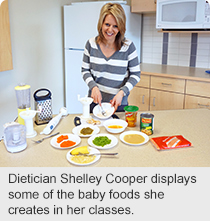
September 9, 2015
Story and photo by Heather Marcoux
For new parents, a baby’s move from breast milk or formula to food can be daunting.
That’s why Alberta Health Services offers Infant Nutrition classes to help parents transition their baby to solid foods, and to make baby food using kitchen implements they may already have at home.
 “The majority of participants in these classes are first-time parents,” says Shelley Cooper, Public Health dietitian at Johnstone Crossing Community Health Centre in Red Deer. Offered in Red Deer since 2003, the Infant Nutrition class expanded zone-wide in 2011 and is now offered in 29 communities across
“The majority of participants in these classes are first-time parents,” says Shelley Cooper, Public Health dietitian at Johnstone Crossing Community Health Centre in Red Deer. Offered in Red Deer since 2003, the Infant Nutrition class expanded zone-wide in 2011 and is now offered in 29 communities across
the Central Zone.
Parents are encouraged to bring their infants to the class, which focuses on creating a positive feeding relationship. The two-hour workshop also highlights why babies need to start on high-iron foods at six months, and why introducing different food textures is important.
“There is a critical window of texture progression for infants,” explains Cooper, who says most store-bought baby food is pureed, and doesn’t expose babies to different textures as they grow.“If babies aren’t progressed to different textures, they can become difficult, picky eaters when they’re older.”
Mother-of-three Jennifer Bunch knows all about the challenges parents face when dealing with a food-selective child. She has a picky four-year-old at home, and is getting ready to introduce her nearly six-month-old twins to pureed foods.
“For my first child, I mostly fed store-bought food,” says Bunch, who was inspired by the variety of different foods presented in the class.
“I never thought of serving my child chickpeas, or grating an apple.”
Betty Bell, another class participant, agrees.
“I didn’t know there were so many options,” says Bell, who watches her seven-month-old granddaughter during the week. Bell says the class helped her realize that in many cases, the baby can eat what the rest of the family is having, as long as it is prepared differently.
“If you’re cooking chicken that night, just cook up a little bit of plain chicken too, without the spices,” she says.
Cooper says chicken is one example of the high-iron foods infants this age could be eating.
“You want to start high iron solids at six months, because the baby’s stores of iron become depleted by then,” she says, adding that meat alternatives (like chickpeas or kidney beans) can be prepared with a simple potato masher.
Cooper also shows parents how to prepare vegetables, fruit and infant cereal using a number of different tools, including hand mixers, food mills and food processers. The class ends with a taste test between store-bought and homemade baby foods.
“I was surprised at how good some of the homemade baby foods tasted,” says Bunch.